Submitted: January 16, 2014 Accepted: January 25, 2014 Published: May 10, 2014
Corresponding Author: Sugeng Heri Suseno, Department of Aquatic Product Technology, Faculty of Fisheries and Marine Sciences, Bogor Agricultural University, Jl. Agatis Darmaga 16680, Bogor, Indonesia
Improving the Quality of Sardine Oil from Bali-Indonesia Using Passive
Filter (Centrifugation)
Sugeng Heri Suseno, Yosephina M.J. Batafor, Nurjanah and Ayu Fitri Izaki
Department of Aquatic Product Technology, Faculty of Fisheries and Marine Sciences, Bogor Agricultural University, Jl. Agatis Darmaga 16680 Bogor, Indonesia
Abstract: Fish oil contains polyunsaturated fatty acids, especially omega-3. Fish oil industry by-product cannot be used because of the low quality so it needs to be purified by treatment with passive filters (centrifugation). The purpose of this study is to determine the best time and speed of passive filter treatment (centrifugation) to improve the quality of fish oil. Fish oil done purification with centrifugation treatments with the time and speed differences. Fish oil treatment has been done then analyzed yield, secondary primary oxidation parameters and clarity values. Treatment of 2500 rpm 45 min is characteristic of the best combination of speed centrifugation treatment and time, seen from the statistical analysis of secondary and primary oxidation parameters and also can meet the standards.
Keywords: Centrifugation, passive filter, refining, sardine oil, secondary primary oxidation
INTRODUCTION
Fish oil is one of processed fishery products that contain omega-3 fatty acids such as DHA (Docosahexaenoic Acid) and EPA (Eicosapentaenoic acid) which is essential for health. Fish oil is widely used one of them as a pharmaceutical product. Omega-3 fatty acids in fish oil are very important for the brain, retina, spermatozoa, visual acuity and cognitive abilities (Hashimoto et al., 2005).
Fishmeal and canning process produces by-product sardine oils containing large enough omega-3 fatty acids in high levels and can be used as a source of omega-3 fatty acids. Fish oil from the process can still not be used, it needs to purification step is used as a food source. Suseno et al. (2011) stated the quality of fish oil by-product of fish meal and fish canning industry is to feed, not for food, with the content of soapstock is quite high at 20%, the value for the primary oxidation peroxide (peroxide value) 4.4 (meq/kg), free fatty acid value 1.25 (% oleic), p-anisidine value 31.79 (meq/kg) and total oxidation value of 40.59 (meq/kg).
Fish oil purification efforts with an effective and efficient method are very important to improve the quality of fish oils so suitable for consumption. Purification of fish oil is expected to increase the value-added fish oil, a by-product of fishmeal and fish canning industry. Fish oil purification can be carried out through a passive filtration treatment. Treatment of passive filtration commonly used is the use of centrifuges and filter paper to separate the soap stock, solid particles and other impurities in fish oil. Suseno et al. (2011) say that the treatment of centrifugation on
purification of fish oil is more effective in reducing the stock of soap and impurities compared with the use of filter paper. The purpose of this study is to determine the best time and speed of passive filter treatment (centrifugation) to improve the quality of fish oil.
MATERIALS AND METHODS
The main material used in this study is sardine oil (Sardinella sp.) from Bali, Indonesia. Other supporting materials are the materials used for the analysis of the quality of fish oil in the form of distilled water, glacial acetic acid, chloroform, a solution of potassium iodine (KI) saturated solution of sodium thiosulfate (Na2S2O3) 0.1 N, 0.1 N KOH solution, phenolphthalein indicators, 96% ethanol, 1% starch, isooctan, reagent p-anisidine, n-hexane. Equipments used include erlenmeyer glass, aluminum foil, magnetic stirrer, digital scales, Pasteur pipette, burette, stative, 2500 UV-Vis spectrophotometer LaboMed brands, high speed refrigerated centrifuge himac HITACHI CR 21G brand, water bath, micro pipette, bulb, test tubes and pumpkin drinks.
Fish oil purification: Sardine oil purification is done by using passive filters (centrifugation) with combination treatment speed (2500, 4500, 6500, 8500 and 10500 rpm, respectively) and time (15, 30 and 45 min, respectively) at a temperature of 10°C until analysis of quality fish oil was conducted.
Adv. J. Food Sci. Technol., 6(5): 609-615, 2014
value (AOAC, 2000, method No. 965.33b), p-anisidine value (IUPAC, 1987, method No. 2.504), total oxidation value (AOCS, 1997) and clarity (wavelength 450, 550, 620, 665 and 700 nm, respectively) (AOAC, 1995).
Data analysis: Result of refining process was statistically processed using ANOVA by SPSS software version 16.0 to see the regression parameter coefficients, percent significance (confidence interval) and the pattern of interaction of factors that significantly influence the response.
RESULTS AND DISCUSSION
The yield of sardine oil centrifugation results: The yield is certain percentage of the desired part of the whole piece of material. Crude sardine oil is centrifugated with a combination of treatments speed (2500, 4500, 6500, 8500 and 10500 rpm, respectively) and time (15, 30 and 45 min, respectively) at a temperature of 10°C to separate the soap stock contained in fish oil. The yield of sardine oil produced after centrifugation treatment is presented in Table 1.
Table 1 shows that after passive filter treatment, yield values of sardine oil decreased. The yield value of
the sardine oil centrifugation was highest at 10500 rpm 15 min treatment (95.33 w/w), whereas the lowest yield values are at 10500 rpm 45 min treatment (53.67 w/w). Soap stocks mainly composed of water and solvent, free fatty acids and sterols and can contain organic phosphate, Monoacylglycerols (MAG), Diacylglycerols (DAG), Triglycerides (TAG), polyalcohols, carbohydrates and other small parts. Soapstocks efficient separation of neutralization typically use centrifugal separator (O'Brien et al., 2000). Abdillah (2008) states that the resulting low yield can be caused by high non-oil fractions in fish oil that come in after the oil saponified fraction undergo neutralization. The resulting yield value is strongly influenced by the homogeneity of the sample to be separated.
Free Fatty Acids (FFA): Free Fatty Acids (FFA) value is an indicator of the level of hydrolysis of triglycerides in fish oil. The results of the analysis of free fatty acids value of sardine oil with the treatment of centrifugation is presented in Fig. 1.
The analysis showed the highest values of free fatty acids produced by treatment of centrifugation 8500 rpm 15 min (4.860.07%) and the lowest value in the treatment of centrifugation 2500 rpm 45 min (4.230.71%). Statistical analysis showed that the treatment speed, time, the combination of speed and
Table 1: The yield centrifugation using 600 g of sardine oil
Treatments (speed and time combination) at 10°C Centrifugation results Soap stock Yields (w/w)
2500 rpm 15 min 510 90 85.00
Fig. 2: Peroxide values of sardine oil with centrifugation treatments
Fig. 3: P-anisidine values of sardine oil with centrifugation treatments
time of centrifugation did not significantly affect (p>0.05) to the value of free fatty acids (Fig. 1). Bimbo (1998) suggest specification quality crude fish oil with a free fatty acid content ranged from 1 to 7%, but typically ranges from 2 to 5%, while Young (1986) states that the maximum acceptable value of 4.0%. The presence of free fatty acids in oil due to oil undergoes hydrolysis process. High oil hydrolysis rate due to the large number of constituents hydrolysis component amount of oil that is high water or high lipase activity in the oil.
Peroxide Value (PV): Peroxide value is the most important oxidation value to determine the degree of damage to the oil or fat. The results of the analysis of the peroxide value of sardine oil with the treatment combination of speed and time of centrifugation is presented in Fig. 2.
The analysis showed the highest peroxide values generated by treatment centrifugation 8500 rpm 45 min (8.751.25 meq/kg) and the lowest value in the treatment of centrifugation 2500 rpm 45 min (2.500 meq/kg). Statistical analysis showed that the treatment speed, time, combined speed and time of centrifugation
affected significantly affected (p<0.05) on the peroxide value (Fig. 2). Peroxide values with the best treatment centrifugation 2500 rpm 45 min (2.500 meq/kg) to meet the standards of the International Fish Oil Standards (IFOS (European Food Safety Authority), 2011) (≤3.75 meq/kg). Standard peroxide value according to the Council for Responsible Nutrition (CRN (Council for Responsible Nutrition), 2006) is 5 meq/kg. Peroxide test aimed to see how much the content of hydroperoxides in oils. Low peroxide value may be due to the rate of formation of new peroxide is smaller than the rate of degradation into other compounds, the levels of peroxide degrades quickly and react with other substances (Rahardjo, 1996).
P-Anisidine Value (P-AV): P-anisidine values are numbers that predict the presence of compounds hydroperoxide decomposition caused by further oxidation. The results of the analysis of the p-anisidine value of sardine oil with the treatment combination of speed and time of centrifugation is presented in Fig. 3.
Adv. J. Food Sci. Technol., 6(5): 609-615, 2014
Fig. 4: Total oxidation values of sardine oil with centrifugation treatments
(0.280.28 meq/kg) and the lowest value in the treatment of centrifugation 2500 rpm 30 min (0.190.32 meq/kg). Statistical analysis showed that the treatment speed, time, the combination of speed and time of centrifugation did not significantly affect (p>0.05) on p-anisidine value (Fig. 3). P-anisidine value with speed and time of centrifugation treatment can meet the standards of the International Fish Oil Standard (IFOS (European Food Safety Authority), 2011) (≤15 meq/kg). Unsaturated fatty acids are very easily oxidized when interacting with oxygen and high temperatures up to be a compound aldehydes, ketones and other derivatives (Krishnamurthy and Vernon, 1996). P-anisidine test is performed to measure the carbon components that influence the formation of unpleasant odors (off-flavor) results from the oxidation process (EFSA (European Food Safety Authority), 2010).
Total oxidation value (Totox): Analysis of total oxidation is an analysis conducted to determine the presence of different compounds such as hydroperoxides, aldehydes, ketones, mainly produced by the degradation of PUFA in pro-oxidant conditions, especially high temperature, oxygen, metal compounds and light. The results of the analysis of the total oxidation value of sardine oil by treatment centrifugation is presented in Fig. 4.
The results of the analysis showed the highest total oxidation value generated by treatment of centrifugation 8500 rpm 45 min (17.732.52 meq/kg) and the lowest value in the centrifugation of treatment 2500 rpm 45 min (5.230.32 meq/kg). Statistical analysis showed that the treatment speed, time, the combination of speed and time of centrifugation was significantly affected (p<0.05) for the total oxidation value (Fig. 4). The total oxidation value of speed and time of the centrifugation treatment to meet the standards of the International Fish Oil Standard (IFOS (European Food
Safety Authority), 2011) (≤20 meq/kg). The total
oxidation value calculated of two times the peroxide value plus the value of the p-anisidine. It is used to measure the total oxidation of oil by considering both primary and secondary products of oxidation, can be used for assessment of fish oil oxidation during storage (CRN (Council for Responsible Nutrition) 2006). The total oxidation value can be used to measure the progression of the deterioration process that occurs in the oil and provide information on the formation of primary and secondary oxidation products (Hamilton and Rossell, 1986).
Clarity value: Measurements of fish oil clarity done with wavelength: 450, 550, 620, 665 and 700 nm, respectively. Fish oil clarity level is indicated by the value of percent transmission read on a spectrophotometer. The highest value of percent transmission and approaching 100% indicates that fish oil was observed to have a good level of clarity. The results analysis of percent transmission of sardine oil with the treatment combination of speed and time of centrifugation at 5 wavelengths are presented in Fig. 5 to 9.
The analysis showed the highest value of fish oil percent transmission at a wavelength of 450 nm generated by treatment of centrifugation 6500 rpm 15 min (49.37 0.85%) and the lowest value in the treatment of centrifugation 8500 rpm 45 min (33.77 0.73%). Statistical analysis showed that time the treatment of centrifugation affect (p 0.05) to the value of clarity (Fig. 5). Figure 5 shows at a wavelength of 450 nm, the treatment of centrifugation 6500 rpm 15 min is the most effective treatment to fish oil clarity seen from the greatest percent transmission.
Fig. 5: Percent transmission of sardine oil clarity (450 nm)
Fig. 6: Percent transmission of sardine oil clarity (550 nm)
Fig. 7: Percent transmission of sardine oil clarity (620 nm)
clarity (Fig. 6). Figure 6 shows at a wavelength of 550 nm, the treatment of centrifugation 6500 rpm 15 min is the most effective treatment to fish oil clarity seen from the greatest percent transmission.
The analysis showed the highest value of fish oil percent transmission at wavelength of 620 nm
Adv. J. Food Sci. Technol., 6(5): 609-615, 2014
Fig. 8: Percent transmission of sardine oil clarity (665 nm)
Fig. 9: Percent transmission of sardine oil clarity (700 nm)
620 nm, the treatment of centrifugation 6500 rpm 15 min is the most effective treatment to fish oil clarity seen from the greatest percent transmission.
The analysis showed the highest value of fish oil percent transmission at wavelength of 665 nm generated by treatment of centrifugation 6500 rpm 15 min (93.971.30%) and the lowest value in the treatment of centrifugation 8500 rpm 45 min (90.890.95%). Statistical analysis showed that the treatment of centrifugation time affected (p<0.05) to the value of clarity (Fig. 8). Figure 8 shows at a wavelength of 665 nm, the treatment of centrifugation 6500 rpm 15 min is the most effective treatment to fish oil clarity seen from the greatest percent transmission.
The analysis showed the highest value of fish oil percent transmission at wavelength of 700 nm generated by treatment of centrifugation 2500 rpm 30 min (97.270.90%) and the lowest value in the treatment of centrifugation 8500 rpm 45 min (95.171.2%). Statistical analysis showed that the treatment of centrifugation time affected (p<0.05) to the value of clarity (Fig. 9). Figure 9 shows at a wavelength of 700 nm, the treatment of centrifugation 2500 rpm 30 min
is the most effective treatment to fish oil clarity seen from the greatest percent transmission.
CONCLUSION
Treatment of 2500 rpm 45 min is characteristic of the best combination of speed and time of centrifugation treatment, seen from the statistical analysis of secondary and primary oxidation parameters and also can meet the standards. The best clarity value with percent transmission values approaching 100 are on centrifugation treatment of 6500 rpm 15 min. The treatment time and speed of centrifugation gave a significantly different effect on the value of the oxidation of primary and secondary parameters except the value of free fatty acids.
ACKNOWLEDGMENT
REFERENCES
Abdillah, M.H., 2008. Refining oil from fish processing waste. Thesis, Bogor Agricultural University, Bogor, ID.
AOAC, 1995. Official Methods of Analysis of the Association of Official Analytical Chemist. AOAC Inc., Washington, US.
AOAC, 2000. Official Methods of Analysis of The Association of Agricultural Chemists. 17th Edn., AOAC Inc., Washington, US.
AOCS, 1997. Official Methods and Recommended Practices of the American Oil Chemists' Society. Official Method cd 8-53 Peroxide Value, cd18-90 p-ansidine Value, cg 3-91 Recommended Practices for Assessing Oil Quality and Stability. AOCS Press, Urbana, US.
AOCS, 1998. Official Methods and Recommended Practices of the American Oil Chemists Society. 5th Edn., AOCS Press, Champaign, US.
Bimbo, A.P., 1998. Guidelines for characterizing food-grade fish oils. Inform. Int. News Fats Oils Relat. Mater., 9(5): 473-483.
CRN (Council for Responsible Nutrition), 2006. Voluntary Monograph. Retrieved form: http:// www. crausa.org/pdfs/O3FINALMONOGRAPH doc.pdf (Accessed on: March 12th, 2011).
EFSA (European Food Safety Authority), 2010. Scientific opinion on fish oil for human consumption. Food hygiene, including rancidity. EFSA J., 8(10): 1874.
Hamilton, R.S. and J.B. Rossell, 1986. Analysis of Oils and Fats. Elsevier Applied Science, London, pp: 23-32.
Hashimoto, M., S. Hossain, H. Agdul and O. Shido, 2005. Docosahexaenoic acid-induced amelioration on impairment of memory learning in amyloid beta-infused rates relates to the decreases of amyloid beta and cholesterol levels in detergent-insoluble membrane fractions. Biochim. Biophys. Acta, 1738(1-3): 91-98.
IFOS (International Fish Oils Standard), 2011. Fish Oil Purity Standards. Retrieved from: http:// www. omegavia. com/ best-fish-oil-supplement-3. (Accessed on: September 10th, 2013).
IUPAC, 1987. Standard Methods for the Analysis of Oils Arld Fats and Derivative. In: Paquot, C. and A. dan Hautfenne (Eds.), 7th Edn., Blackwell Scientific, Oxford (GB).
Krishnamurthy, R.G. and C.W. Vernon, 1996. Salad Oil and Oil-based Dressings. In: Bailey’s Industrial Oil and Fat Technology; Edible Oil and Fat Product. Product and Application Technology. 4th Edn., Wiley-Interscience Publication, New York, 3: 193-224.
O'Brien, R.D., W.E. Farr and P.J. Wan, 2000. Introduction to Fats and Oils Technology. AOCS Press, Champaign, Illinois.
Rahardjo, S., 1996. Production of fat oxidation one cause of coronary heart. Agritech, 15: 31-35. Suseno, S.H., A.Y. Tajul and N.W.A. Wan, 2011. The
use of passive filtration for optimization of magnesol xl function for improving the quality of Sardinella lemuru oil. Int. Res. J. Biochem. Bioinformatic,1(5): 103-113.




